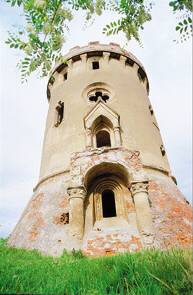
The Castle from ARDUD
The archeological discoveries made in Oas-Land, Ardud, Medies, Homorod etc. have brought to light abundant evidence regarding the stone- and bronze age settlements in this area; there is also proof of the Getic-Dacian communities continuing to inhabit these regions after the Roman Conquest; later on, this territory was part of the Voievodeship led by Menumorut, one of the defense fortresses in the X th century being at Satu Mare ( Castrum Zotmar ), as mentioned in Anonymus's Chronicle. Teutonic colonists brought in 1006 by queen Gisela have settled around the city core - Villa Zotmar - inhabited by the natives; later on, other German colonists who had previously lived beyond the Somes river in the city of Mintiu, also gathered closer. After 1543, when the stronghold comes into the possession of the Bathory family, changes are made to the Somes riverbed to protect the southern wing of the fortress, so that it remains on an island connected to the main roads by three bridges over the river. At 1562, the fortress is placed under siege by the ottoman armies led by Pasha Abraham from Buda and Pasha Maleoci from Timisoara. Then the Habsburgs attack the fortress and the Transsilvanian armies burn it down before leaving it. By appointment of the Austrian general Lazar Schwendi, the reconstruction of the stronghold begins according to the plans of the Italian architect Ottavio Baldigara, in the manner of the Italian fortifications shaped as pentagons with five watchtowers. Although in the Middle Ages Mintiu and Satu Mare were two distinct cities separated by the Somes, between 1712-1715 they gradually unite administratively. The act that consecrated the union was the Diploma issued by Carol the VIth on January 2nd 1721, the city of Satu Mare also being granted the royal-free-city statute. Due to the economic and commercial privileges acquired beginning with the XIIIth century, Satu Mare becomes an important center of crafthttp://www.qsl.net/yo5ofh/smen guilds.
The XVIIIth century marks the beginning of an intense urbanization process, some representative edifices dating back to this period: the old city hall, the inn, the military barracks, the Greek-catholic and reformed churches etc. In 1823, the Urban Development Planning Committee of the city - who direct and control the whole edilitary activity - is set up. The first park appears in 1844 and street paving - begun in 1805 - advances rapidly. This is also the time when the first industrial companies are founded: the steam mill, the brick factory, the Neuschloss wood-processing factory, the lumber factory, the Princz and the Unio factories. Situated at the crossroads of commercial routes, Satu Mare becomes an important railway center. The railway to Carei is built in 1871, the one to Sighet in 1872, the one to Baia Mare in 1894 and others (to Ardud, Bixad ) after 1900.
[ About me | Acronyms | CW | Data Sheets | Docs | Download | E-mail | HOME | Ham projects | Hobby circuits | Photo galery | PIC | QTH photos |
Sign in my guestbook | View my guestbook ]
© 2001 - YO5OFH, Csaba Gajdos